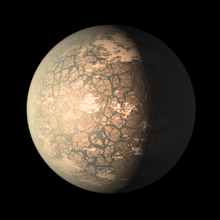
In astronomy and astrobiology, the circumstellar habitable zone (CHZ), or simply the habitable zone, is the range of orbits around a star within which a planetary surface can support liquid water given sufficient atmospheric pressure. The bounds of the CHZ are based on Earth's position in the Solar System and the amount of radiant energy it receives from the Sun. Due to the importance of liquid water to Earth's biosphere, the nature of the CHZ and the objects within it may be instrumental in determining the scope and distribution of planets capable of supporting Earth-like extraterrestrial life and intelligence.

Kepler-62f is a super-Earth exoplanet orbiting within the habitable zone of the star Kepler-62, the outermost of five such planets discovered around the star by NASA's Kepler spacecraft. It is located about 980 light-years from Earth in the constellation of Lyra.

The habitability of red dwarf systems is presumed to be determined by a large number of factors from a variety of sources. Modern evidence indicates that planets in red dwarf systems are unlikely to be habitable, due to their low stellar flux, high probability of tidal locking and thus likely lack of magnetospheres and atmospheres, small circumstellar habitable zones and the high stellar variation experienced by planets of red dwarf stars, impeding their planetary habitability. However, the ubiquity and longevity of red dwarfs are factors which could provide ample opportunity for any possibility of habitability to be realized. As red dwarf stars are by far the most common type of star in the universe, astronomers study how each of the many factors, and the interactions among them, could affect their habitability to learn more about the frequency and most likely locations of extraterrestrial life and intelligence.

HD 219134 b is one of at least five exoplanets orbiting HD 219134, a main-sequence star in the constellation of Cassiopeia. HD 219134 b has a size of about 1.6 REarth, and a density of 6.4 g/cm3 and orbits at 21.25 light-years away. The exoplanet was initially detected by the instrument HARPS-N of the Italian Telescopio Nazionale Galileo via the radial velocity method and subsequently observed by the Spitzer telescope as transiting in front of its star. The exoplanet has a mass of about 4.5 times that of Earth and orbits its host star every three days. In 2017, it was found that the planet likely hosts an atmosphere.

TRAPPIST-1 is a cool dwarf star noted for its seven known exoplanets. It lies in the constellation Aquarius about 40.66 light-years away from Earth, with a surface temperature of about 2,566 kelvins. Its radius is slightly larger than Jupiter and it has a mass of about 9% of the Sun. It is estimated to be 7.6 billion years old, making it older than the Solar System. The discovery of the star was first published in 2000.
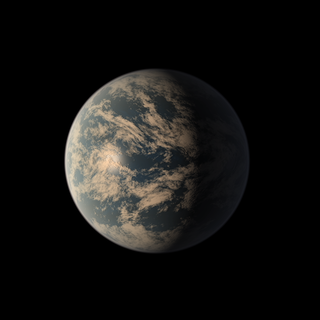
TRAPPIST-1d, also designated as 2MASS J23062928-0502285 d, is a small exoplanet, which orbits on the inner edge of the habitable zone of the ultracool dwarf star TRAPPIST-1, located 40.7 light-years away from Earth in the constellation of Aquarius. The exoplanet was found by using the transit method, in which the dimming effect that a planet causes as it crosses in front of its star is measured. The first signs of the planet were announced in 2016, but it wasn't until the following years that more information concerning the probable nature of the planet was obtained. TRAPPIST-1d is the second-least massive planet of the system and is likely to have a compact hydrogen-poor atmosphere similar to Venus, Earth, or Mars. It receives just 4.3% more sunlight than Earth, placing it on the inner edge of the habitable zone. It has about <5% of its mass as a volatile layer, which could consist of atmosphere, oceans, and/or ice layers. A 2018 study by the University of Washington concluded that TRAPPIST-1d might be a Venus-like exoplanet with an uninhabitable atmosphere. The planet is an eyeball planet candidate.
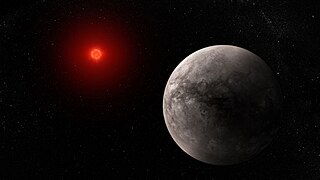
TRAPPIST-1b, also designated as 2MASS J23062928-0502285 b, is a mainly rocky exoplanet orbiting around the ultra-cool dwarf star TRAPPIST-1, located 40.7 light-years away from Earth in the constellation of Aquarius. The planet was detected using the transit method, where a planet dims the host star's light as it passes in front of it. It was first announced on May 2, 2016, and between 2017 and 2018, more studies were able to refine its physical parameters.

TRAPPIST-1c, also designated as 2MASS J23062928-0502285 c, is a mainly rocky exoplanet orbiting around the ultracool dwarf star TRAPPIST-1, located 40.7 light-years away from Earth in the constellation Aquarius. It is the third most massive and third largest planet of the system, with about 131% the mass and 110% the radius of Earth. Its density indicates a primarily rocky composition, and observations by the James Webb Space Telescope announced in 2023 suggests against a thick CO2 atmosphere, however this does not exclude a thick abiotic oxygen-dominated atmosphere as is hypothesized to be common around red dwarf stars.

TRAPPIST-1g, also designated as 2MASS J23062928-0502285 g and K2-112 g, is an exoplanet orbiting around the ultra-cool dwarf star TRAPPIST-1, located 40.7 light-years away from Earth in the constellation Aquarius. It was one of four new exoplanets to be discovered orbiting the star in 2017 using observations from the Spitzer Space Telescope. The exoplanet is within the optimistic habitable zone of its host star. It was found by using the transit method, in which the dimming effect that a planet causes as it crosses in front of its star is measured.

TRAPPIST-1e, also designated as 2MASS J23062928-0502285 e, is a rocky, close-to-Earth-sized exoplanet orbiting within the habitable zone around the ultracool dwarf star TRAPPIST-1, located 40.7 light-years away from Earth in the constellation of Aquarius. Astronomers used the transit method to find the exoplanet, a method that measures the dimming of a star when a planet crosses in front of it.
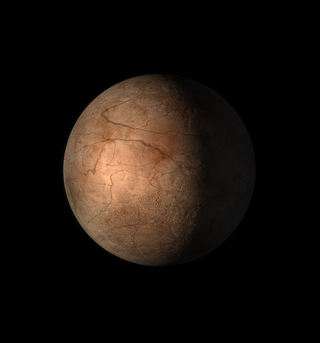
TRAPPIST-1h, also designated as 2MASS J23062928-0502285 h, is an exoplanet orbiting around the ultra-cool dwarf star TRAPPIST-1, located 40.7 light-years away from Earth in the constellation Aquarius. It was one of four new exoplanets to be discovered orbiting the star in 2017 using observations from the Spitzer Space Telescope. In the following years, more studies were able to refine its physical parameters.
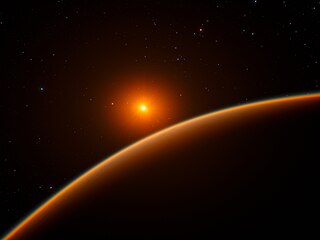
LHS 1140 is a red dwarf in the constellation of Cetus. Based on stellar parallax measurement, it is 48.8 light-years away from the Sun. 'LHS' refers to the Luyten Half-Second Catalogue of stars with proper motions exceeding half a second of arc annually. The star is over 5 billion years old and has only about 18% the mass of the Sun and 21% of its radius. LHS 1140's rotational period is 130 days. No flares have been observed.

LHS 1140 b is a massive, dense rocky planet orbiting within the conservative habitable zone of the red dwarf LHS 1140. Discovered in 2017 by the MEarth Project, LHS 1140 b is over 6 times the mass of Earth and over 60% larger in radius, putting it within the super-Earth category of planets. It is one of the densest planets found, with a density almost twice that of Earth, along with a high surface gravity of about 2.41 times Earth's. LHS 1140 b orbits entirely within the star's habitable zone and gets 41% the incident flux of Earth. The planet is only 40 light-years away and transits its star, making it an excellent candidate for atmospheric studies with ground-based and/or space telescopes.

Ross 128 b is a confirmed Earth-sized exoplanet, likely rocky, that is orbiting within the inner habitable zone of the red dwarf Ross 128, at a distance of around 11 light-years from Earth. The exoplanet was found using a decade's worth of radial velocity data using the European Southern Observatory's HARPS spectrograph at the La Silla Observatory in Chile. Ross 128 b is the nearest exoplanet around a quiet red dwarf, and is considered one of the best candidates for habitability. The planet is only 35% more massive than Earth, receives only 38% more starlight, and is expected to be a temperature suitable for liquid water to exist on the surface, if it has an atmosphere.
Luyten b is a confirmed exoplanet, likely rocky, orbiting within the habitable zone of the nearby red dwarf Luyten's Star. It is one of the most Earth-like planets ever found and is the fourth-closest potentially habitable exoplanet known, at a distance of 12 light-years. Only Proxima Centauri b, Ross 128 b, and Gliese 1061 d are closer. Discovered alongside Gliese 273c in June 2017, Luyten b is a Super-Earth of around 2.89 times the mass of Earth and receives only 6% more starlight than Earth, making it one of the best candidates for habitability. In October 2017 and 2018, the nonprofit organization METI sent a message containing dozens of short musical compositions and a scientific "tutorial" towards the planet in hopes of contacting any potential extraterrestrial civilizations.
TOI-700 d is a near-Earth-sized exoplanet, likely rocky, orbiting within the habitable zone of the red dwarf TOI-700, the outermost planet within the system. It is located roughly 101.4 light-years (31.1 pc) away from Earth in the constellation of Dorado. The exoplanet is the first Earth-sized exoplanet in the habitable zone discovered by the Transiting Exoplanet Survey Satellite (TESS).

Kepler-1649c is an Earth-sized exoplanet, likely rocky, orbiting within the habitable zone of the red dwarf star Kepler-1649, the outermost planet of the planetary system discovered by Kepler’s space telescope. It is located about 301 light-years (92 pc) away from Earth, in the constellation of Cygnus.
Kepler-737b is a super-Earth exoplanet 669 light years away. There is a chance it could be on the inner edge of the habitable zone.
LP 890-9, also known as SPECULOOS-2 or TOI-4306, is a high proper motion red dwarf star located 105 light-years (32 pc) away from the Solar System in the constellation of Eridanus. The star has 12% the mass and 15% the radius of the Sun, and a temperature of 2,871 K. As of 2022, it is the second-coolest star found to host a planetary system, after TRAPPIST-1.
